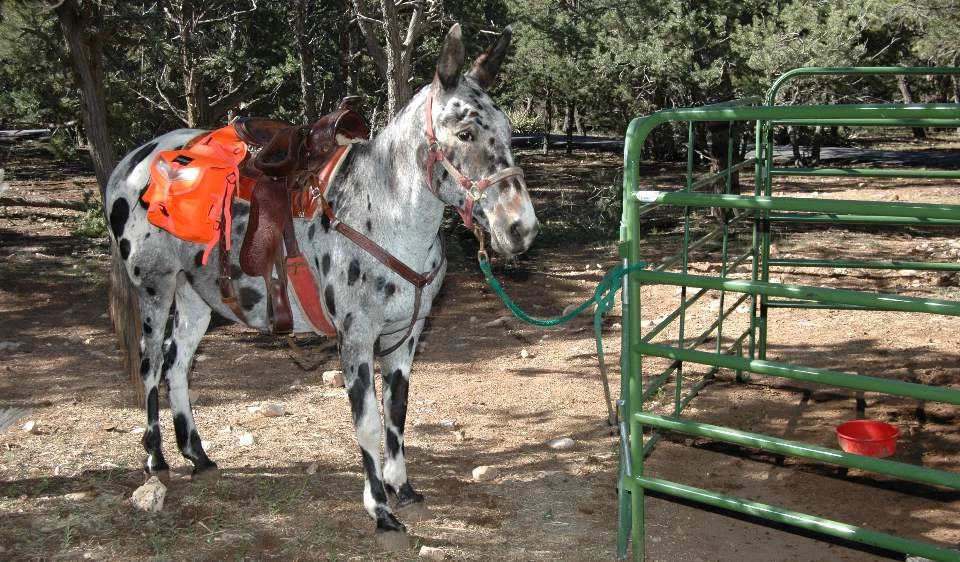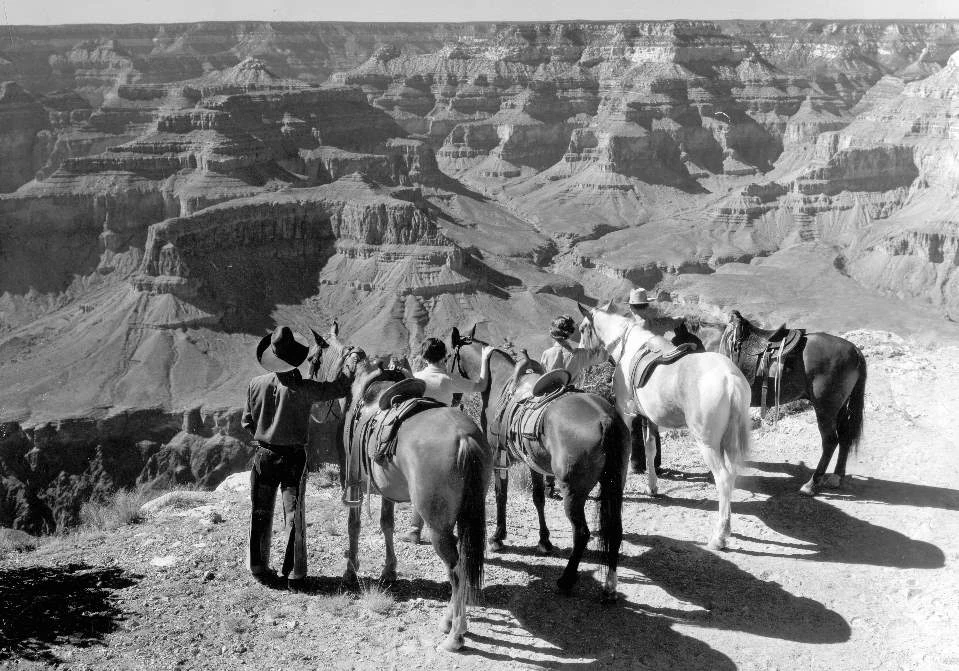
Equines—horses, mules, and burros—played an important role in Grand Canyon's history. These creatures assisted in building many of the canyon's first trails and still help maintain them today. Some of the first park visitors descended into the canyon on the back of equines. Visitors today experience unique perspectives and nostalgia while riding on designated park trails. Prior to riding, private stock users must check with the Backcountry Information Center by phone or in person. Riders are responsible for the safety of both themselves and their equine(s), as well as knowing and abiding by park regulations. General InformationSize: Overnight limited to six equines with riders. Day use limited to 12 equines with riders. A rider may lead no more than five head, tied together in single file. Maximum of one pack animal per hiker. Backcountry permit: Required for Inner Canyon and North Rim campsites. Prohibited: Llamas, goats, and other non-equine stock. Health: Must carry a negative Coggins test certificate for each equine (required). Dead or injured animals: Removal becomes the owner's responsibility. Tying stock: Tree savers required. Hitch rails available at all camps and at many corridor trail locations. Snow and ice: If present or forecasted, caulked shoes required. Parking: Day and overnight parking available on the South Rim at the Backcountry Information Center. Limited parking on North Rim; inquire at the Backcountry Information Center. Stock is not allowed on paved roads, except where it is necessary to cross to or from a designated trail. On the South Rim: stock is not allowed on the Rim Trail between Pipe Creek Overlook and First Trailview. Trails Open to EquinesSouth Rim
North Rim
Tuweep
Stock is not allowed on paved roads, except where it is necessary to cross to or from designated trails. Go with the FlowAs a safety precaution, commercial mule strings have the right-of-way. Riders must pull off the trail and yield, backtracking if necessary. Travel in these directions during specific times: Bright Angel Trail Downhill After 9 am in summer (April to October); 10 am in winter (November to March) South Kaibab Trail Downhill after 1 pm North Kaibab Trail Downhill before 7 am Day UseNo permits required for day use. Prior to riding from the South Rim, check in with the Backcountry Information Center and Xanterra Livery Management. On the North Rim, check in with the Backcountry Information Center and Canyon Trail Rides. Overnight UseBackcountry permits: Overnight use on the North Rim or at Inner Canyon campsites requires a permit from the Backcountry Permits Office. Enter the lottery for backcountry permits by the first of the month, four months prior to the start date. Permits may still be available after the lottery is complete, and can be booked by contacting the Backcountry Permits Office at 928-638-7875. Inner Canyon Permit Cost: $10 per permit plus $15 for each person and $15 for each equine per night. North Rim Horse Camp: (May 15 to November 1; water may be shut off earlier, weather depending) One site; 0.25 miles (0.4 km) north of the North Kaibab Trailhead; pit toilet, picnic table, campfire ring, potable water, and small corral. One person must camp with stock. Maximum six equines, six people, and two vehicles; maximum trailer length 30 feet (9 m). North Rim Horse Camp Permit Cost: $10 per permit plus $4 for each person and $4 for each equine per night. Tuweep Campground: No camping; no trailers. Inner Canyon: Bright Angel Campground, near Phantom Ranch, and Cottonwood Campground, along the North Kaibab Trail, each accept one equine group per night. Phantom Ranch guests must have one person camp with the animals; hitching rail provided, no corral available; permit required. South Rim Horse Camp: Two sites at Mather Campground include picnic tables, campfire rings, water, two corrals with water troughs, and feeders. Restrooms nearby. No electricity. Per site maximum of six equines, six people, and two vehicles; maximum trailer length 30 feet (9 m). South Rim Horse Camp Permit Cost: $25 per site per night. Sites may be reserved on Recreation.gov. by searching for "HA" site in the toolbar. Feed and WaterFeed: Clean trailers, hooves, coat, mane, and tails prior to entering the park. Feed stock weed-free forage or processed feed a few days before the trip. To prevent introducing non-native plants in the park, use only certified weed-free forage— hay, straw, and mulch. Proof of certification tags required. Forage may not be taken beyond trailheads. Use pelletized feed, hay cubes, and grain products in the backcountry. Do not leave feed on the ground; use a feedbag or tarp. Pack out unused feed. Grazing not permitted. Storage: Feed should be stored in rodent-proof containers. At camp, use a long rope to hang feed from pack poles. Water: Available at Havasupai Gardens day-use area and Bright Angel and Cottonwood campgrounds. Animals may be watered directly from natural water sources where streams cross maintained trails. Equines cannot linger in stream crossings; use collapsible canvas buckets to transport water. ContactGrand Canyon Backcountry Information and Permits Office South Rim: North Rim: Mule operations and stock use planning documents can be found at https://parkplanning.nps.gov/grca Additional backcountry info can be found on the following webpages.
|
Last updated: March 12, 2025
